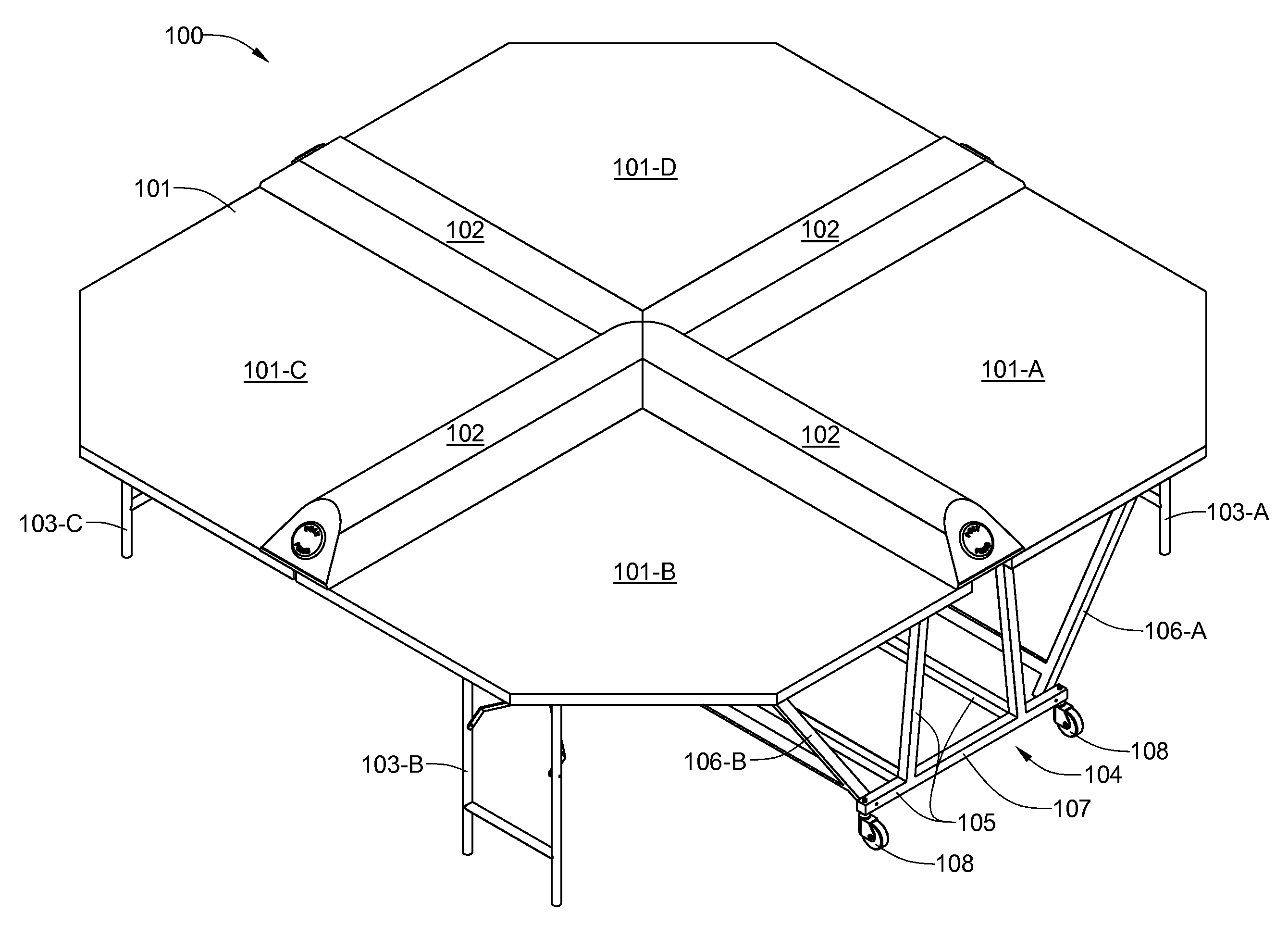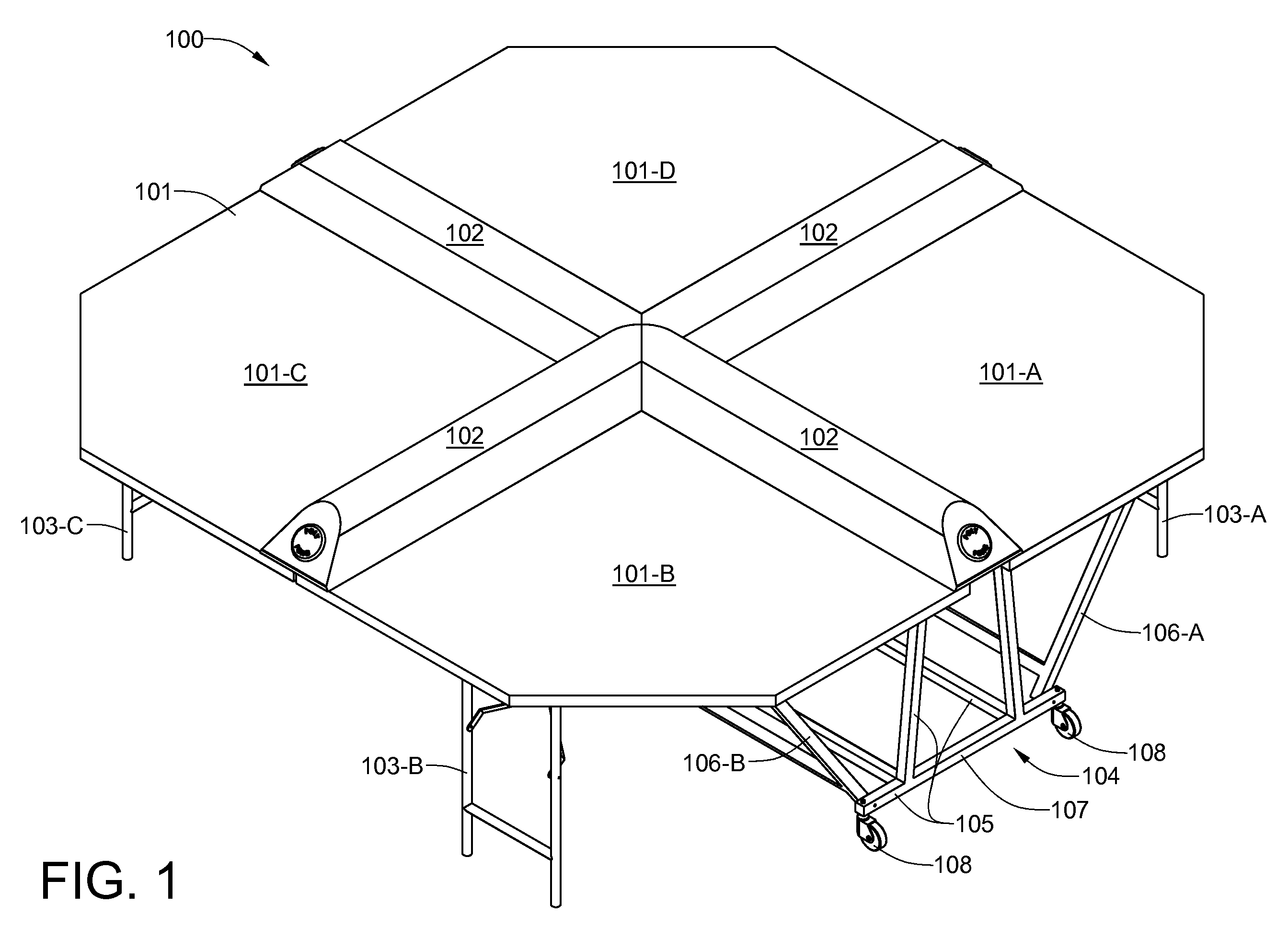Table tennis game having a playing surface divided into multiple independent playing stations by intersecting rigid barriers
a technology of rigid barriers and tables, applied in the field of tables and games, can solve the problems of frequent misadjustment or slackness of nets, and the inability to adapt to compact storag
- Summary
- Abstract
- Description
- Claims
- Application Information
AI Technical Summary
Benefits of technology
Problems solved by technology
Method used
Image
Examples
first embodiment
[0060]Referring now to FIG. 1, a first embodiment new game table 100 has an octagonal table top 101 comprised of four separate quarter-section pieces: inner quarter-section pieces 101-A and 101-B; and outer quarter-section pieces 101-C and 101-D. Four identical rigid barriers 102, are positioned on the tabletop 101 in a cross formation. The outer edge of each quarter-section piece 101-A, 101-B, 101-C and 101-D is supported by a folding leg assembly 103-A, 103-B, 103-C and 103-D (not shown in this view), respectively. The abutting edges of the inner quarter-section pieces 101-A and 101-B are further supported by a dolly 104 that is made from square cross-section tubing 105, provided with first and second support members 106-A and 106-B, which are rotatably coupled to opposite sides of the base or lower portion 107 of the dolly 104. Each inner quarter-section piece 101-A and 101-B is attached to the dolly only via its associated support member 106-A and 106B, respectively. In addition...
second embodiment
[0074]Referring now to FIGS. 21 and 22, a junior, or smaller, second embodiment of the new game table is made of four identical quarter-section pieces 2101. In FIG. 22, four such pieces 2101 are arranged in an array ready for assembly. It will be noted that each piece 2101 has both tabs 2102 and recesses 2103. The tabs 2102 on one piece are interlockable with the recesses 2103 on an adjacent piece so that they can fit together like pieces of a jigsaw puzzle. Binder clips 2201 will be used to lock the various pieces together as shown in the next drawing figure.
[0075]Referring now to FIG. 23, the four quarter-section pieces 2101 shown in FIG. 22 have been assembled as a junior second embodiment table assembly 2300. Binder clips 2201 have been used to lock the various pieces together by placing one at the end of each seam 2301 so that it overlaps and squeezes two adjacent pieces. For maximum stability, a binder clip 2201 may be placed at both the inner and outer ends of each seam 2301....
fourth embodiment
[0083]Referring now to FIG. 43, three barriers 3800 have been placed on the fourth embodiment game table 3700. It will be noted that all three barriers 3800 intersect at a point 4301 in the center of the table 3700 and are all equiangularly spaced from one another.
[0084]Referring now to FIGS. 44 to 49 different shapes of rigid barriers are shown which can be used on the first embodiment game table 100 of FIG. 1. However, these shapes can also be applied to the rigid barriers used on the second, third and fourth embodiments of the new game table. FIG. 44 shows a rigid barrier 4400 having an equilateral triangular cross section; FIG. 45 shows a rigid barrier 4500 having a parabolic cross section; FIG. 46 shows a rigid barrier 4600 having a half-hyperbolic cross section; FIG. 47 shows a rigid barrier 4700 having an equilateral trapezoidal cross section; FIG. 48 shows a rigid barrier 4800 having an equilateral cross section that is uniformly sloped on the sides thereof and curved to an ...
PUM
 Login to View More
Login to View More Abstract
Description
Claims
Application Information
 Login to View More
Login to View More - R&D
- Intellectual Property
- Life Sciences
- Materials
- Tech Scout
- Unparalleled Data Quality
- Higher Quality Content
- 60% Fewer Hallucinations
Browse by: Latest US Patents, China's latest patents, Technical Efficacy Thesaurus, Application Domain, Technology Topic, Popular Technical Reports.
© 2025 PatSnap. All rights reserved.Legal|Privacy policy|Modern Slavery Act Transparency Statement|Sitemap|About US| Contact US: help@patsnap.com



